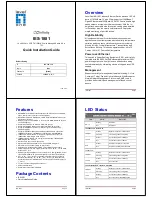
4 Configuration
D-Link Web Smart Switch User Manual
38
Value 1-200000000 -
Define a value between 1 and 200000000 to determine the external cost. The
lower the number, the greater the probability the port will be chosen to forward packets.
Migrate:
Setting this parameter as
Yes
will set the ports to send out BPDU packets to other bridges,
requesting information on their STP setting. If the Switch is configured for RSTP, the port will be capable to
migrate from 802.1d STP to 802.1w RSTP. Migration should be set as yes on ports connected to network
stations or segments that are capable of being upgraded to 802.1w RSTP on all or some portion of the
segment.
Edge:
Selecting the
True
parameter designates the port as an edge port. Edge ports cannot create loops,
however an edge port can lose edge port status if a topology change creates a potential for a loop. An edge
port normally should not receive BPDU packets. If a BPDU packet is received, it automatically loses edge
port status. Selecting the
False
parameter indicates that the port does not have edge port status. Selecting
the
Auto
parameter indicates that the port have edge port status or not have edge port status automatically.
Priority:
Specify the priority of each port. Selectable range is from 0 to 240, and the default setting is 128.
The lower the number, the greater the probability the port will be chosen as a root port.
P2P:
Choosing the
True
parameter indicates a point-to-point (P2P) shared link. P2P ports are similar to edge
ports, however they are restricted in that a P2P port must operate in full-duplex.
Like edge ports, P2P ports transition to a forwarding state rapidly thus benefiting from RSTP. A p2p value of
false
indicates that the port cannot have p2p status.
Auto
allows the port to have p2p status whenever
possible and operate as if the p2p status were true. If the port cannot maintain this status, (for example if the
port is forced to half-duplex operation) the p2p status changes to operate as if the p2p value were
False
. The
default setting for this parameter is
Auto
.
Restricted Role:
Toggle between
True
and
False
to set the restricted role state of the packet. If set to
True
,
the port will never be selected to be the Root port. The default value is
False
.
Restricted TCN:
Toggle between
True
and
False
to set the restricted TCN of the packet. Topology Change
Notification (TCN) is a BPDU that a bridge sends out to its root port to signal a topology change. If set to
True
, it stops the port from propagating received TCN and to other ports. The default value is
False
.
Click
Apply
for the settings to take effect. Click
Refresh
to renew the page.
L2 Functions > Link Aggregation > Port Trunking
The Trunking function enables the combining of two or more ports together to increase bandwidth. Up to
eight Trunk groups may be created, and each group consists up to eight ports. Select the ports to be
grouped together, and then click
Apply
to activate the selected Trunking groups. Two types of link
aggregation can be selected:
Static -
Static link aggregation.
LACP -
LACP (Link Aggregation Control Protocol) is enabled on the device. LACP allows for the
automatic detection of links in a Port Trunking Group.
Disable -
Remove all members in this trunk group.
Figure 4.50 – L2 Functions > Link Aggregation > Port Trunking
NOTE:
Each combined trunk port must be
connected to devices within the same VLAN
group.
















































